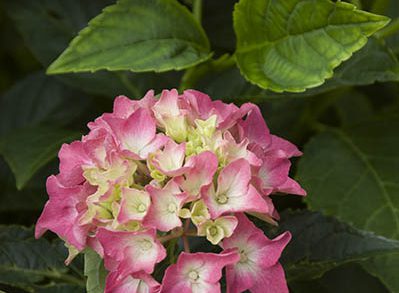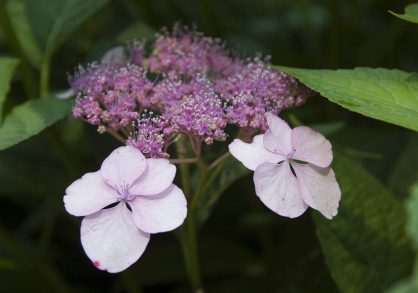Video: Jay Potter
During a stroll through Cornell Botanic Gardens in August, your attention would be captured by the assortment of large pom-pom-shaped flowers of hydrangeas.
Ninety-one different types of hydrangeas, representing eight species, are generously dispersed throughout the gardens around the Nevin Welcome Center and concentrated in the Zucker Shrub Collection within the F.R. Newman Arboretum.
There are 75 different species of hydrangea native to China, Japan, Korea, the Himalayas, Indonesia, and the Americas, with the greatest diversity of species in Japan, China, and Korea. Plants in wild populations typically have few showy flowers, while cultivated hydrangeas (more than 600 named cultivars) have been bred to have an abundance of larger flowers, which come in a variety of different shapes, sizes, and colors.
The name hydrangea comes from the Greek words “hydor” meaning water and “angos” meaning vessel. Together they translate to “water barrel,” which is fitting because these plants require a lot of water.
While undeniably beautiful, the symbolic meaning of hydrangea varies considerably among different cultures.
Japanese Tradition and Symbolism
The hydrangea was first cultivated in Japan, where it is often called Ajisai. They bloom most profusely during the rainy season from June to early July.
Although hydrangea can be toxic when consumed, leaves from Hydrangea serrata var. thunbergii, or mountain hydrangea, are safe to consume and are widely used to make a sweet tea known as amacha. The tea is made to celebrate Buddha’s birthday during the Hana-Matsuri flower festival on April 8. Participants perform a Buddha-bathing ceremony by pouring amacha over a statue of Buddha in a flower-decked shrine to commemorate the birth of Buddha. According to legend, nine dragons descended from the heavens and poured holy water over the newborn.
Blue hydrangea flowers became associated with heartfelt emotion, gratitude, and apology, after a Japanese emperor gave them to the family of the girl he loved to make up for neglecting her.
Western Meanings
In contrast, hydrangeas developed a negative sentiment in Europe, where they have been used to declare arrogance, boastfulness, and vanity because they produce many magnificent flowers, but very few seeds. English men in the 1800s used to send hydrangeas to women who rejected them, accusing them of frigidity.
In the United States, using hydrangeas in a wedding bouquet has come to symbolize enduring love, everlasting friendship, and family bonds. The blooms are also given on fourth wedding anniversaries to express appreciation and heartfelt emotion.
A Note on Color
While hydrangeas have developed different meanings across cultures, the symbolism of specific bloom colors are fairly consistent.
- Blue flowers often convey forgiveness, gratitude, and understanding
- White flowers symbolize purity, grace, and tolerance
- Pink flowers carry the meaning of love and sincere emotions
- Purple flowers are associated with pride, royalty, and abundance
No matter what color, size, or shape they are, hydrangea flowers add beauty to your garden or summer bouquet. Explore these highlights from the extensive collection of hydrangeas at Cornell Botanic Gardens.


